Cooking with a cast iron skillet is like taking a journey through culinary history. It’s incredibly durable and channels heat to perfection, making it ideal for cooking a variety of dishes.
I’ve often wondered, is it safe to cook tomatoes in a cast iron skillet? Let’s explore this together!
Key Takeaways
- Cooking tomatoes in a cast iron skillet can be safe if done properly.
- The acidity in tomatoes can potentially strip the skillet of its seasoning.
- Proper care and maintenance of your cast iron skillet are crucial.
- You can minimize risks by using certain cooking techniques.
- Cast iron skillets are versatile and can be used for a variety of cooking tasks.
The Truth About Tomatoes and Cast Iron
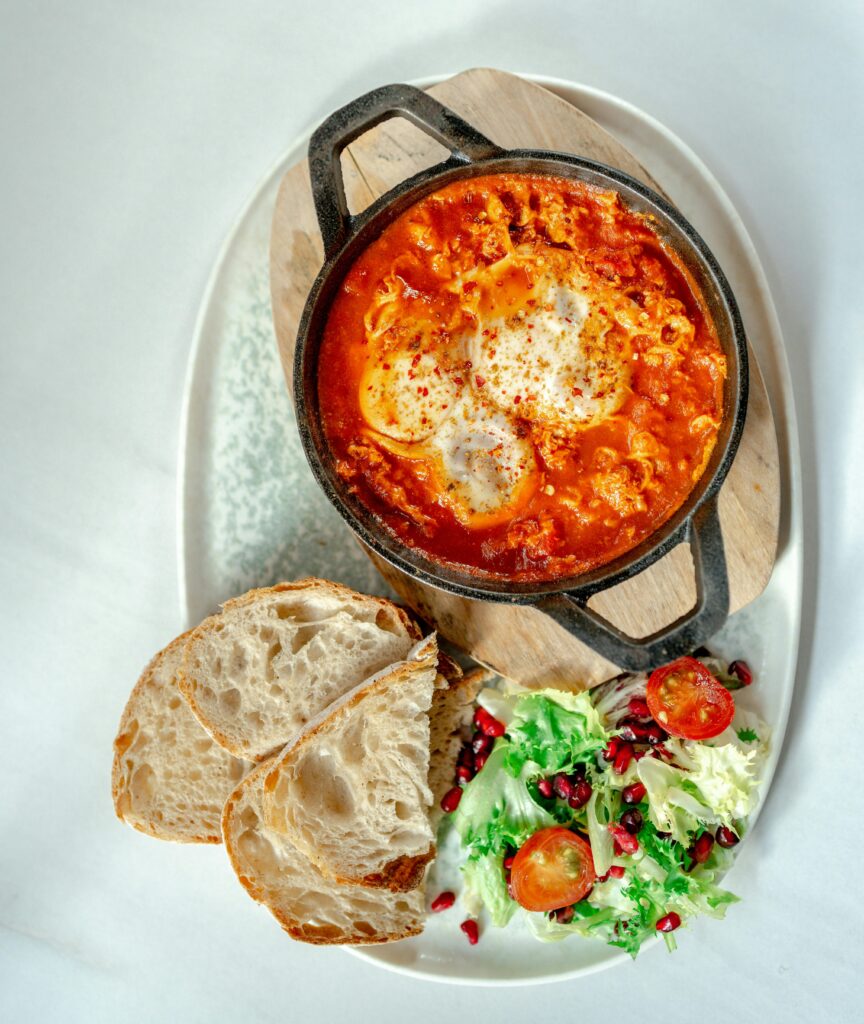
The relationship between tomatoes and cast iron is more complex than you might think. Tomatoes are often discussed in negative terms among cast-iron enthusiasts; rumor has it that they can corrode cast iron and damage these reliable workhorse skillets. But what’s the truth behind this claim?
Cooking acidic ingredients like tomatoes in cast-iron cookware can potentially cause a reaction. The acidity in tomatoes may strip away the seasoning on your cast iron, leading to rust if not properly maintained.
However, this doesn’t mean you can’t cook tomatoes in cast iron at all. It simply requires some care and the right cooking techniques.
When cooking tomatoes or other acidic foods in cast iron, it’s essential to be mindful of the cooking time and the condition of your skillet. A well-seasoned skillet is less likely to react with acidic foods. Additionally, avoiding prolonged cooking times can minimize the risk of damage.
To make the most of cooking tomatoes in cast iron, consider the following tips:
- Use a well-seasoned cast-iron skillet to minimize the risk of reaction.
- Keep your cooking time as short as possible to prevent excessive acidity from affecting the skillet.
- Clean and re-season your skillet after cooking acidic ingredients to maintain its condition.
By understanding the potential interactions between tomatoes and cast iron and applying the right cooking techniques, you can enjoy cooking a variety of delicious dishes while maintaining your cast-iron cookware.
Why The Worry?
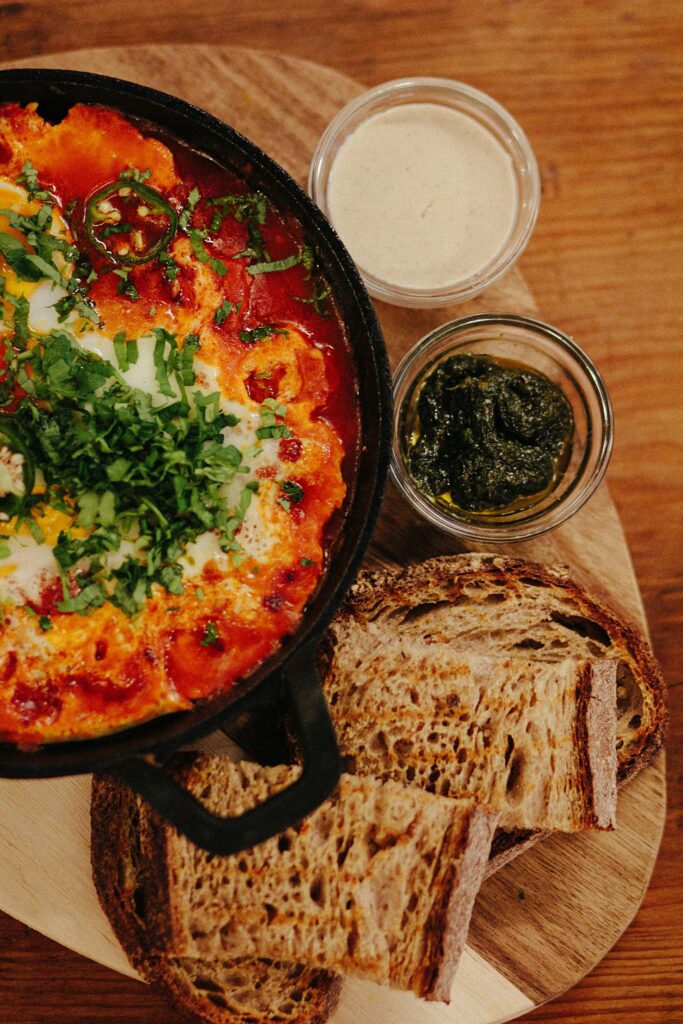
When you cook tomatoes in cast iron, a fascinating chemical reaction occurs. The acidity in tomatoes can potentially react with the metal in your cast iron skillet, causing the leaching of iron into your food. This reaction can also impact the seasoning on your pan.
The acidity in tomatoes comes from malic and citric acids, which are naturally occurring. When these acids come into contact with the iron in your skillet, they can strip away some of the metal, leading to a transfer of iron into your food. While getting extra iron might sound beneficial, it can also result in an off-flavor in your dishes and potentially damage your skillet over time.
To minimize these effects, you can take a few precautions.
First, ensure your cast iron skillet is well-seasoned before cooking tomatoes in it. A robust layer of seasoning acts as a barrier between the acidic tomatoes and the metal. You can also consider cooking methods that reduce the acidity or the contact time between the tomatoes and the skillet.
Tips for Cooking Tomatoes in Cast Iron:
- Cook tomatoes for shorter periods to reduce the reaction time between the acid and the metal.
- Add a small amount of baking soda to neutralize some of the acidity.
- Use a cast iron skillet that is in good condition and well-maintained.
By understanding the science behind cooking tomatoes in cast iron and taking a few simple precautions, you can enjoy delicious, tomato-based dishes while maintaining the integrity of your cast iron skillet.
Preparing Your Cast Iron for Cooking Tomatoes
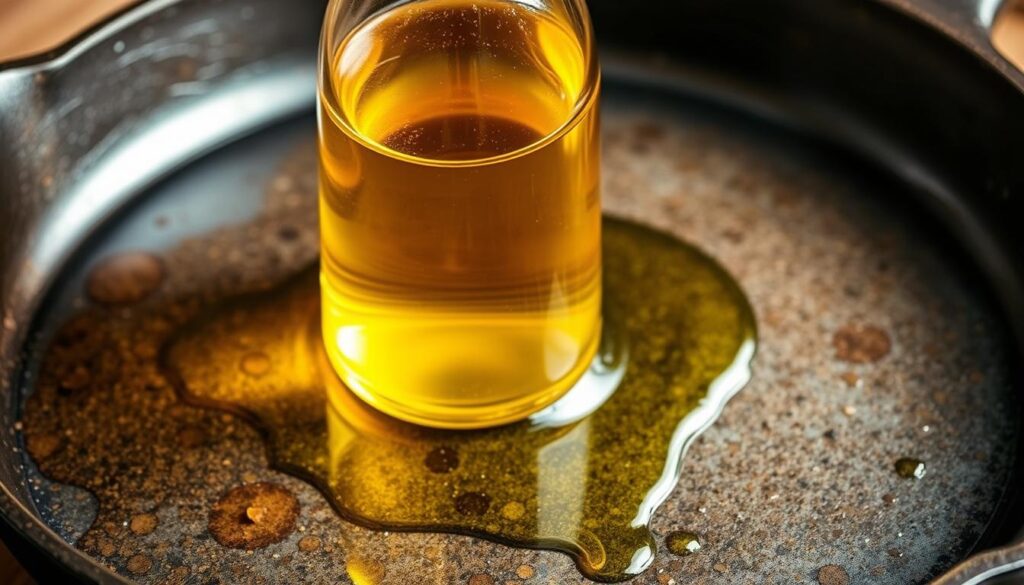
Preparing your cast-iron skillet for cooking tomatoes is a crucial step that can make all the difference in your cooking experience. I’ve learned that a well-seasoned cast-iron skillet is not only durable but also a great cooking companion. To get started, you’ll need to season your skillet, which involves creating a layer of polymerized oil on its surface.
To season a brand-new cast iron pan or re-season an older one, rub a neutral oil, such as avocado, onto the pan’s surface. Then, bake it in a hot oven for about one hour. This process helps to create a non-stick surface that’s perfect for cooking delicate foods like tomatoes. I like to use canola oil because it has a high smoke point and doesn’t impart a strong flavor to your food.
Maintaining the seasoning on your cast-iron skillet is just as important as the initial seasoning process. After each use, simply wipe the skillet clean with a paper towel and apply a thin layer of oil. This will help to prevent rust and keep your skillet in good condition. By following these simple steps, you’ll be able to enjoy cooking with your cast-iron skillet for years to come.
Some additional tips to keep in mind when preparing your cast-iron skillet for cooking tomatoes include:
- Avoid using abrasive cleaners or scourers, as they can damage the seasoning.
- Don’t put your cast-iron skillet in the dishwasher, as the high heat and harsh detergents can cause it to rust.
- If you notice that your skillet is starting to rust, don’t worry! Simply sand off the rust and re-season the skillet.
By following these tips and maintaining your cast-iron skillet properly, you’ll be able to cook delicious tomatoes and enjoy a range of other cooking techniques. Whether you’re a seasoned cook or just starting out, cast-iron cookware is a great addition to any kitchen.
Best Techniques for Tomatoes in Cast Iron
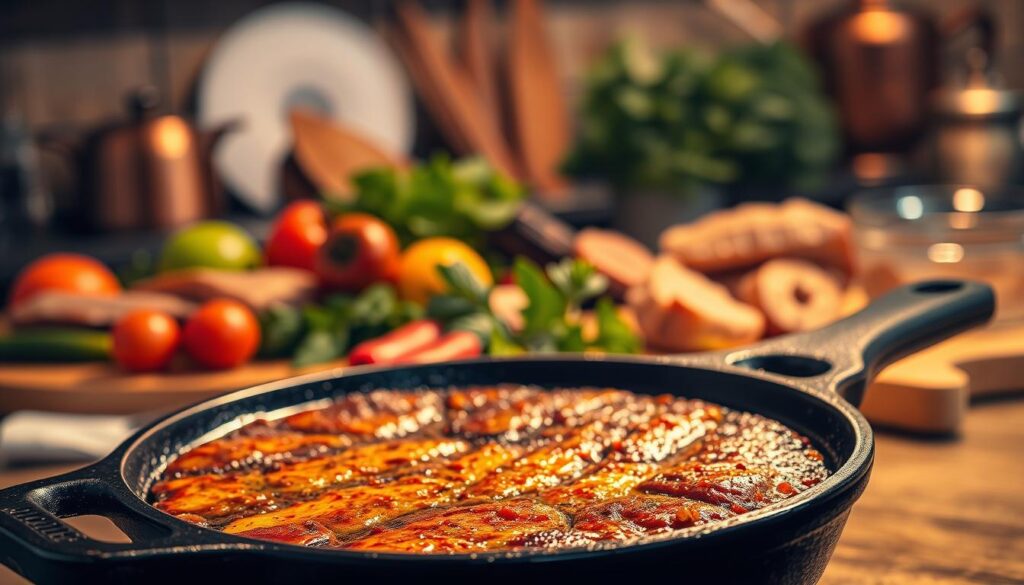
To get the best out of cooking tomatoes in cast iron, a few techniques can make all the difference. When you’re working with acidic ingredients like tomatoes, it’s essential to consider how they might interact with your cast iron skillet.
Cooking tomatoes in cast iron can be a bit tricky, but with the right approach, you can achieve fantastic results. First, make sure your pan is well-seasoned. A good seasoning layer protects your skillet from the acidity of the tomatoes. I’ve found that a well-seasoned pan also makes cooking and cleaning easier.
When cooking tomatoes, you have a couple of options: searing and simmering. Searing is great for getting a nice crust on your tomatoes, while simmering helps to cook them through and blend the flavors. To avoid unwanted flavors or damage to the pan, consider the following tips:
Avoiding Common Cooking Mistakes
- Use shorter simmering times to minimize the interaction between the acidic tomatoes and the cast iron.
- Dilute the tomatoes with other ingredients to reduce their acidity.
- Add acidic ingredients like tomatoes late in the recipe to limit their exposure to the cast iron.
- Be careful to remove acidic dishes from the skillet after they finish cooking to prevent any residual acidity from affecting the pan.
By following these guidelines, you can enjoy cooking tomatoes in your cast iron skillet without worrying about damaging your pan. Remember, the key is to be mindful of the acidity and take steps to mitigate its effects. With a little practice, you’ll be cooking delicious tomato dishes in no time!
One of my favorite ways to cook tomatoes in cast iron is to make a simple tomato skillet dinner. I start by searing some onions and garlic, then add in chopped tomatoes and a bit of olive oil. Let it simmer until the flavors have melded together, and you’ve got a tasty, satisfying meal.
Delicious Cast Iron Tomato Recipes
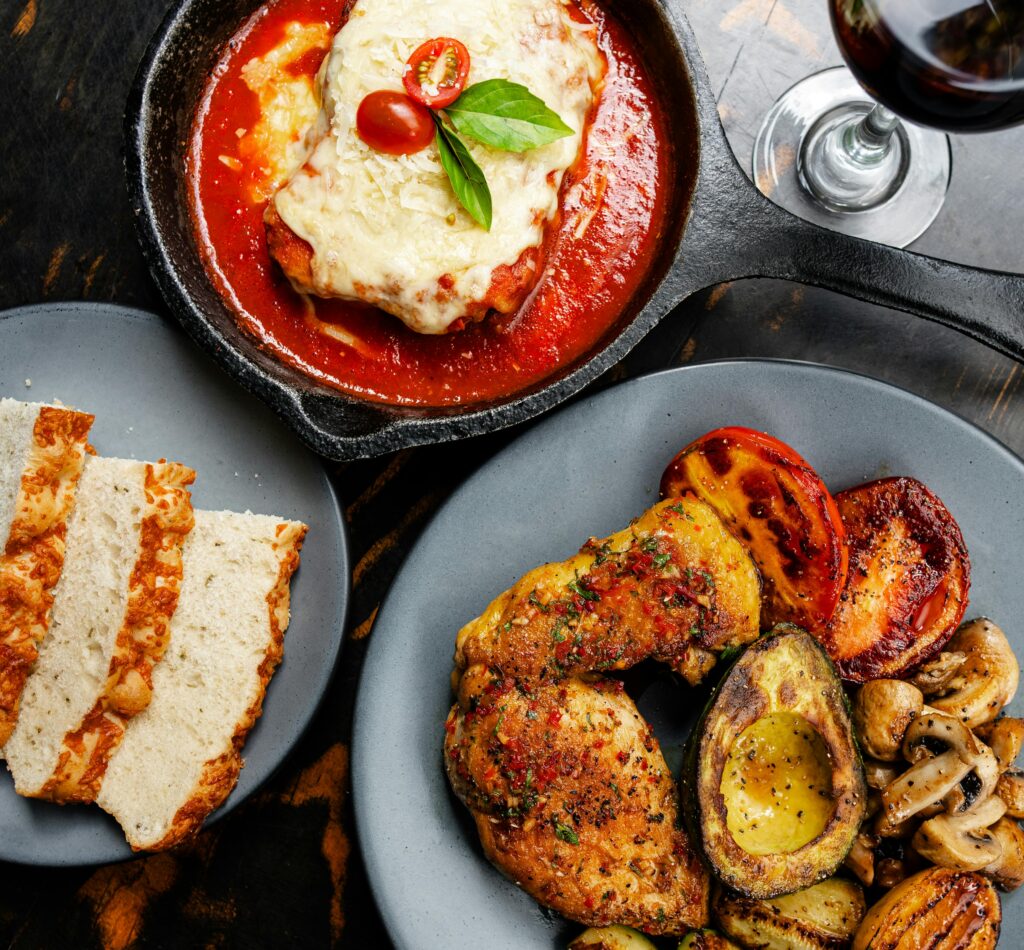
Cast iron skillets are perfect for cooking tomatoes, and I’m excited to share some of my favorite recipes with you. There’s something special about the way cast iron distributes heat that brings out the natural sweetness in tomatoes.
One of my go-to recipes is Shakshuka, a North African dish that’s perfect for brunch or dinner. To make it, you’ll need:
Shakshuka (Eggs in Tomato Sauce)
- 2 large tomatoes, diced
- 1 onion, chopped
- 2 cloves of garlic, minced
- 1 tablespoon olive oil
- Salt and pepper to taste
- 2 eggs
Preheat your cast iron skillet over medium heat, then add the olive oil, onion, and garlic. Cook until the onion is translucent, then add the diced tomatoes and season with salt and pepper. Create two wells in the tomato mixture and crack an egg into each well. Cover the skillet and cook until the eggs are set.
Skillet Tomato Cornbread
Another delicious recipe is Skillet Tomato Cornbread. To make it, you’ll need:
- 1 cup cornmeal
- 1 cup all-purpose flour
- 1/2 cup granulated sugar
- 2 teaspoons baking powder
- 1/2 teaspoon salt
- 1/2 cup unsalted butter, melted
- 1 cup buttermilk
- 2 large eggs
- 1 cup diced tomatoes
Preheat your oven to 400°F (200°C). In a large bowl, combine the cornmeal, flour, sugar, baking powder, and salt. In a separate bowl, whisk together the melted butter, buttermilk, eggs, and diced tomatoes. Add the wet ingredients to the dry ingredients and stir until just combined. Pour the batter into a preheated cast iron skillet and bake for 20-25 minutes, or until a toothpick inserted into the center comes out clean.
These are just a couple of examples of the many delicious recipes you can make using your cast iron skillet and tomatoes. Experiment with different ingredients and techniques to find your new favorite dish!
Final Words: Enjoying and Maintaining Your Cast Iron
Now you’ve learned, cooking tomatoes in a cast iron skillet can be a game-changer. To keep your cast-iron cookware in top condition, regular maintenance is essential. This means re-seasoning your pan periodically to maintain the seasoning and prevent rust.
When it comes to cleaning, avoid using abrasive cleaners or scouring pads, as they can damage the seasoning. Instead, simply wipe out any food residue and give the pan a quick rinse. For tougher messes, mix some baking soda and water to create a paste, and scrub gently.
By following these simple care and maintenance tips, you’ll be able to enjoy cooking with your cast iron skillet for years to come. Experiment with new recipes and cooking techniques, like those we’ve discussed, to get the most out of your cast-iron cookware.
With a little love and care, your cast iron skillet will remain a trusted companion in the kitchen, ready to tackle any dish you throw at it. Happy cooking!
If you want to read the full guide on how to get started with cast iron cooking click here.
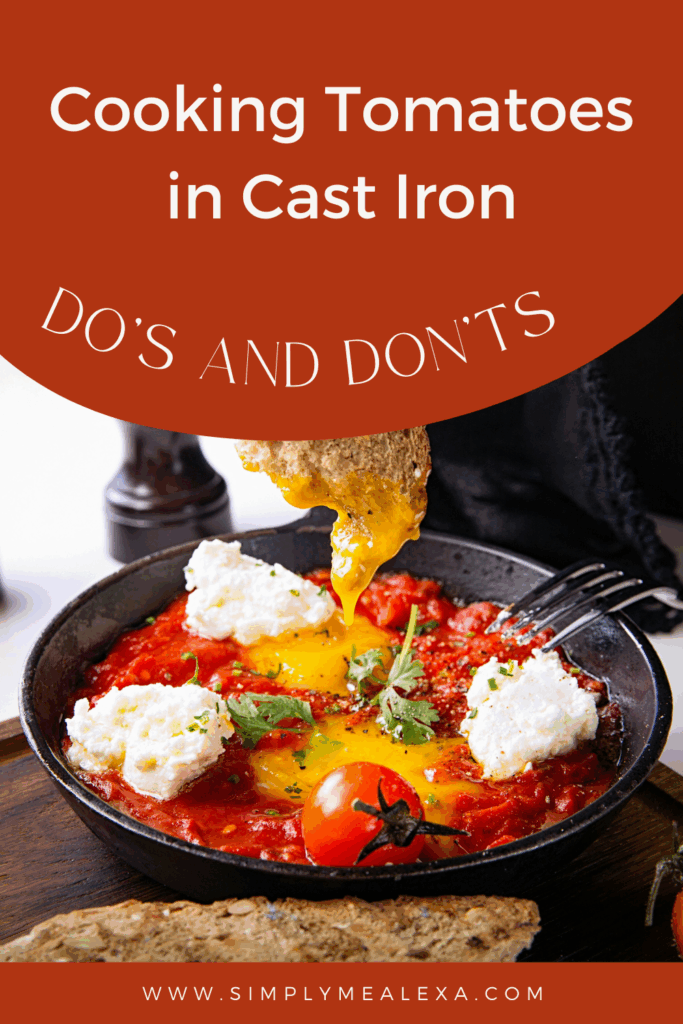
FAQ
Can I cook tomatoes in a cast iron skillet?
Yes, you can cook tomatoes in a cast iron skillet, but it’s essential to understand the potential risks and take steps to minimize them.
Will cooking tomatoes in cast iron ruin the seasoning?
Cooking acidic ingredients like tomatoes can strip away the seasoning if not done properly, but a well-seasoned pan and proper cooking techniques can help maintain the integrity of the cast iron.
How do I prepare my cast iron skillet for cooking tomatoes?
To prepare your cast iron skillet, ensure it’s well-seasoned, and consider applying a thin layer of oil before cooking to protect the seasoning.
What’s the best way to cook tomatoes in cast iron?
To cook tomatoes in cast iron, use techniques like searing and simmering, and adjust cooking times and methods to achieve the best results.
Can I cook tomato sauce in cast iron?
Yes, you can cook tomato sauce in cast iron, but be aware that the acidity in the tomatoes can potentially strip away the seasoning if cooked for an extended period.
How do I maintain my cast iron skillet after cooking tomatoes?
After cooking tomatoes, clean your cast iron skillet thoroughly, dry it, and apply a thin layer of oil to maintain the seasoning and prevent rust.
Are there any cast iron cooking techniques to avoid when cooking tomatoes?
Avoid cooking tomatoes at extremely high heat or for extended periods, as this can damage the seasoning and potentially cause the iron to leach into the food.
Can I use my cast iron skillet for cooking other acidic ingredients?
While it’s generally safe to cook acidic ingredients in cast iron, it’s crucial to follow proper cooking techniques and maintain the seasoning to prevent damage to the pan.

View comments
+ Leave a comment